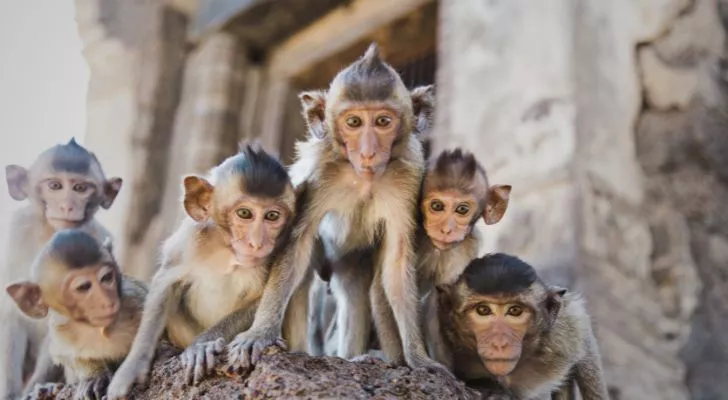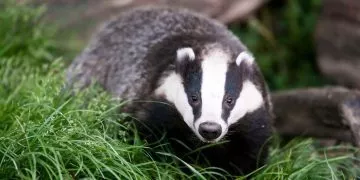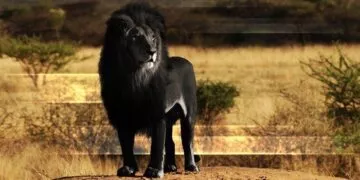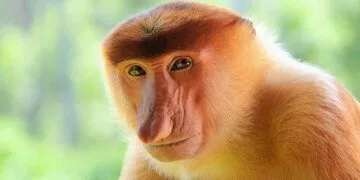Monkeys are adorable, mischievous creatures that love bananas and are excellent tree climbers. They’re primates like humans, and we share many similarities, like opposable thumbs, but there’s more to them than just that.
Keep reading if you want to know how closely related we are to monkeys and other fantastic facts.
Prepare to have your mind blown and satisfy your curiosity about one of the most intelligent animals in the world.
Monkeys and apes may look alike and even share similar habits, but they’re different. The easiest way to tell them apart is to look for a tail; monkeys generally have one, while apes don’t.
So far, we know about 334 monkey species. These are split into the New World monkeys and Old World monkeys.
New World monkeys have prehensile tails for grasping branches and other items. On the other hand, Old World monkeys have shorter tails, which are unsuitable for holding things.
You won’t find native monkeys in North America today, but they used to live there roughly 56 million years ago.
Monkeys went to space long before humans ever did. Albert II became the first monkey to journey outside our planet on June 4, 1949.
Spider monkeys have a bare skin patch on their tail with a unique pattern of grooves resembling fingerprints.
Monkeys love their rest and, on average, spend more time asleep than humans. Some species, like the three-striped night monkey, sleep up to 17 hours daily.
Monkeys are incredibly social creatures that live in groups. A group of monkeys is called a troop, tribe, cartload, or carload.
Monkeys build community relationships by caring for one another. They help each other stay clean by removing parasites and dirt.
White-faced capuchin monkeys have an odd way of bonding. They sometimes pull out each other’s hair, force open their jaws, and poke fingers into their nostrils.
Of all the monkeys in the wild, baboons live the longest, ranging from 35 to 40 years.
Pygmy marmosets are the smallest monkeys in the world, weighing only as much as an apple. Even when fully grown, these monkeys don’t get taller than 6.3 inches (16 centimeters).
Titi monkeys are devoted lovers, spending all their lives with one mate.
Gibraltar is home to a colony of Barbary macaques, the only wild population of monkeys in Europe. Although they’re monkeys, not apes, they’re sometimes called Barbary apes because they don’t have tails.
Barbary macaques are usually led by a strong female monkey caring for the entire group.
Unlike humans, where females do most of the childcare, male titi monkeys are the primary caretakers.
Mandrills are the largest monkeys in the world. Some grow up to 31 inches (78.7 cm) tall and weigh as much as 119 pounds (54 kilograms).
Monkeys love bananas but also love eating other fruits, nuts, and seeds in the forest. Their diet also includes tiny insects, lizards, and eggs.
Patas monkeys can easily run at speeds of up to 34 miles per hour (55 km/hr). This makes them the fastest monkeys in the world.
In some parts of Africa, monkeys are hunted by poachers for their hands and feet. These parts are prized ingredients used in making traditional medicine.
The long-tailed macaques of Bali are smart enough to identify expensive items and steal them from unsuspecting tourists exploring the Uluwatu temple.
Monkeys are among the few animals besides humans that can identify their reflection in the mirror.
Sadly, monkeys are still eaten in some parts of the world today. However, eating monkey meat is risky because we’re so closely related that it’s easy to catch life-threatening diseases from them.
Howler monkeys are the loudest but are only the size of small dogs such as pugs. Their large hyoid bones help them roar loud enough to be heard up to three miles (4.8 km) away.
Emperor tamarins have iconic white mustaches, like the German Emperor Wilhelm II, after whom they were named.
The male proboscis monkey’s large nose, which can grow longer than four inches (10 cm), is how they secure a mate.
In Japan, the macaque monkeys at the Jigokudani Monkey Park love a hot bath. They take a dip in the relaxing natural hot springs on cold days to warm up.
Not all monkeys are great tree climbers; some prefer hanging out on the ground. One such species is the gelada monkey, which lives in the peaks of Ethiopia.
The bright red face of the bald uakari monkey is a sign of good health and helps it attract mates. But if they look paler than usual, it could mean they’re ill.
Monkeys are usually not great swimmers, but some, like proboscis monkeys and some macaques, are great divers.
Macaques have all the anatomical features required to speak like humans. But unfortunately, their brain doesn’t have the capacity to produce intelligent sound.
Elvis Presley’s pet chimpanzee is famous, but few know he got a monkey first. This was Jayhew, the pet spider monkey he got in 1956.
Monkeys typically have a sweet tooth, but a few, like the Asian colobine monkeys, don’t.
All male tamarins and spider monkeys are dichromatic, meaning they can’t see red or green shades. But the females could either be trichromats, like humans, or dichromats, like the males.
Monkeys are smart enough to solve math problems like counting numbers and adding.
Brazilian capuchin monkeys can make sharp stones that look like tools made by early humans. These monkeys also use stone tools in mating rituals, to crush food, and to dig the earth.
Monkeys grieve the loss of a troop member, and mothers sometimes mourn by carrying their deceased infants for weeks.
The Hindu religion has a monkey god called Hanuman, who can fly, grow to any size he wants, and has control of a massive monkey army.
When a monkey grins or blows a kiss at you, it’s not a sign of affection. Rather, it usually means they’re angry, so you may want to step back.
Spider monkeys locked in captivity alone can die from loneliness. They prefer to congregate in groups of about fifty in the wild.
Myanmar is home to a species of snub-nosed monkeys that go into sneezing fits whenever it rains. They do this because of the unusual upturned shape of their nostrils that collects the rainwater.
There’s a temple in Nepal called Swayambhunath Monkey Temple, which houses hundreds of monkeys.
The only European monarch ever murdered by a monkey was King Alexander of Greece. He died from sepsis at 27 after getting bitten by a monkey that had attacked his dog.
The oldest monkey fossil uncovered by scientists belongs to the 26.5 million-year-old Canaanimico amazonensis.
Humans didn’t evolve from monkeys or any other modern apes. Instead, we share an ancestor from around 6-8 million years ago.
Monkeys sometimes sniff each other’s poop to help the group stay healthy. This habit helps them identify sick monkeys in the group so they can keep their distance.
Scientists first discovered the rhesus factor in the blood of rhesus monkeys. This important discovery has helped doctors care for pregnant women if their babies have an incompatible rhesus blood type.
Monkeys are so scared of snakes that they’ll run and hide even from toy ones.
Capuchin monkeys have made a name in Hollywood. You can spot them in many movies, including Pirates of the Caribbean, Outbreak, Zookeeper, and George of the Jungle.
Ethiopian geldas are some of the most social primates, often living in large groups that could get as many as 1200.

Monkeys are social primates who love hanging out in groups where they take care of one another. They’re intelligent, too, capable of working out simple arithmetic and other math problems.
And because we’re closely related to monkeys, studying them has helped us make great strides in modern medicine.
Sadly, the survival of monkeys today is threatened by poachers who hunt them for meat and parts for traditional medicine.


















